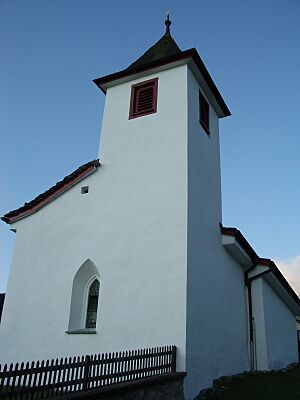Casti-Wergenstein facts for kids
Quick facts for kids
Casti-Wergenstein
|
||
|---|---|---|

Casti
|
||
|
||
| Country | Switzerland | |
| Canton | Graubünden | |
| District | Viamala | |
| Area | ||
| • Total | 25.62 km2 (9.89 sq mi) | |
| Elevation | 1,489 m (4,885 ft) | |
| Population
(December 2015)
|
||
| • Total | 52 | |
| • Density | 2.030/km2 (5.26/sq mi) | |
| Postal code |
7433
|
|
| Surrounded by | Andeer, Clugin, Donat, Mathon, Safien, Sufers | |
Casti-Wergenstein, also known as Casti-Vargistagn, was a small town in the Graubünden area of Switzerland. It was a municipality, which is like a local government area. On January 1, 2021, Casti-Wergenstein joined with three other nearby towns – Donat, Lohn, and Mathon – to create a new, bigger municipality called Muntogna da Schons.
Contents
History of Casti-Wergenstein
Casti-Wergenstein was formed in 1923. Before that, it was two separate towns: Casti and Wergenstein. They decided to join together to form one municipality.
The town of Casti was first mentioned in old documents in the year 1204. Wergenstein was first written about a bit later, in 1219.
Geography and Landscape
Casti-Wergenstein covered an area of about 25.62 square kilometers (about 9.9 square miles). A large part of this land, about half, was used for farming. Forests covered about 9% of the area.
A small part of the land, less than 1%, had buildings or roads. The rest, about 40%, was unproductive land. This means it was not used for farming, buildings, or forests. It might have been rocky areas or high mountains.
The municipality was located in the Viamala Region of Graubünden. This region is known for its beautiful mountains and valleys.
Population and People
Casti-Wergenstein was a very small community. In 2019, it had a population of 54 people. A small number of these residents, about 7.7%, were people from other countries.
In 2015, about 17% of the population were children and teenagers (under 20 years old). Most of the people, about 67%, were adults between 20 and 64 years old. Seniors, those over 64, made up about 15% of the population.
Most of the buildings in Casti-Wergenstein were single-family homes. In 2015, there were 21 private homes, with an average of about 2.5 people living in each home.
The chart below shows how the population of Casti-Wergenstein has changed over many years:

- Before 1923, combined populations of Casti and Wergenstein.
Education in Casti-Wergenstein
Many adults in Casti-Wergenstein have a good education. About 82% of people aged 25 to 64 have completed either a non-mandatory upper secondary education (like high school) or even higher education, such as a university degree.
Economy and Jobs
The economy of Casti-Wergenstein was a mix of farming and service jobs. This means that both agriculture and jobs like tourism or other services were important.
In 2014, there were 28 people working in the municipality. Ten of these people worked in farming businesses. There were no jobs in manufacturing or construction. The remaining 18 jobs were in the service sector, which includes things like shops, hotels, or other services.
The unemployment rate in Casti-Wergenstein was very low, at 0% in 2011. This means everyone who wanted a job had one.
Languages Spoken
Casti-Wergenstein was once a place where almost everyone spoke Romansh. This is a special language spoken in parts of Switzerland. However, over time, especially since World War I, the German language became more common.
Today, both Romansh and German are official languages in the municipality. In 2000, most people (about 55%) spoke Romansh. German was the second most common language (about 43%), and a small number of people (about 1.8%) spoke Italian.
The table below shows how the languages spoken in Casti-Wergenstein have changed over the years:
| Language | Census of 1980 | Census of 1990 | Census of 2000 | |||
|---|---|---|---|---|---|---|
| Number | Percentage | Number | Percentage | Number | Percentage | |
| German | 7 | 19.44% | 14 | 32.56% | 24 | 42.86% |
| Romansh | 29 | 80.56% | 29 | 67.44% | 31 | 55.36% |
| Italian | 0 | 0.00% | 0 | 0.00% | 1 | 1.79% |
| Population | 36 | 100% | 43 | 100% | 56 | 100% |
See also
 In Spanish: Casti-Wergenstein para niños
In Spanish: Casti-Wergenstein para niños






